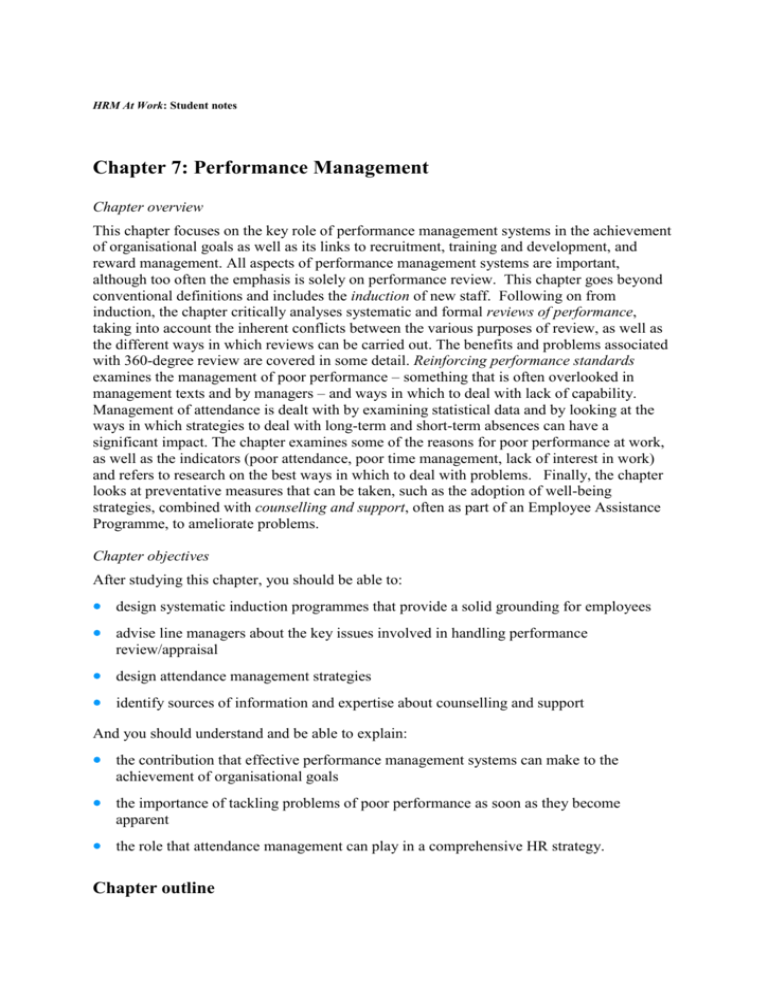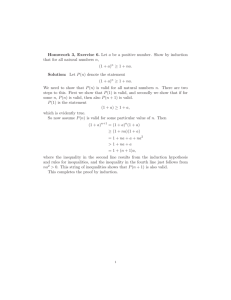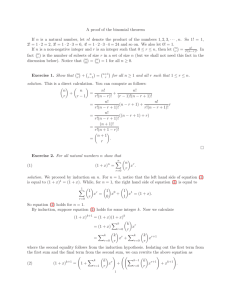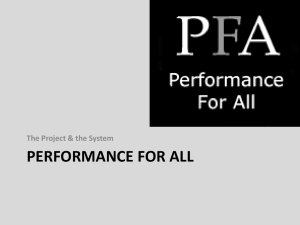HRM At Work: Student notes Chapter 7: Performance Management
advertisement

HRM At Work: Student notes Chapter 7: Performance Management Chapter overview This chapter focuses on the key role of performance management systems in the achievement of organisational goals as well as its links to recruitment, training and development, and reward management. All aspects of performance management systems are important, although too often the emphasis is solely on performance review. This chapter goes beyond conventional definitions and includes the induction of new staff. Following on from induction, the chapter critically analyses systematic and formal reviews of performance, taking into account the inherent conflicts between the various purposes of review, as well as the different ways in which reviews can be carried out. The benefits and problems associated with 360-degree review are covered in some detail. Reinforcing performance standards examines the management of poor performance – something that is often overlooked in management texts and by managers – and ways in which to deal with lack of capability. Management of attendance is dealt with by examining statistical data and by looking at the ways in which strategies to deal with long-term and short-term absences can have a significant impact. The chapter examines some of the reasons for poor performance at work, as well as the indicators (poor attendance, poor time management, lack of interest in work) and refers to research on the best ways in which to deal with problems. Finally, the chapter looks at preventative measures that can be taken, such as the adoption of well-being strategies, combined with counselling and support, often as part of an Employee Assistance Programme, to ameliorate problems. Chapter objectives After studying this chapter, you should be able to: design systematic induction programmes that provide a solid grounding for employees advise line managers about the key issues involved in handling performance review/appraisal design attendance management strategies identify sources of information and expertise about counselling and support And you should understand and be able to explain: the contribution that effective performance management systems can make to the achievement of organisational goals the importance of tackling problems of poor performance as soon as they become apparent the role that attendance management can play in a comprehensive HR strategy. Chapter outline Performance management systems This section provides an overview of the role of performance management systems and its importance to organisational success, and looks at the critical role played by line managers. Induction and employee socialisation Here, the importance of induction and employee socialisation is demonstrated by reference to recent research on benefits as well as on the problems that arise when induction is not given the priority it merits. Advice is given on planning an induction programme, making reference to the three broad perspectives on the aims of the process – administration, social integration, and cultural control. Performance review This section critically analyses the variety of systems of performance review, with particular reference to the dichotomy between review for reward and review for developmental purposes. The section emphasises the importance of objectivity, particularly where review is used for reward, and the different means by which it can be achieved, questioning whether use of ratings systems leads to increases in performance or to demotivation. Consideration is given to who carries out the review – whether it is the line manager, bpeers, self-assessment, or whether 360-degree review is used. Finally, this section analyses the major problems with performance review, including validity, conflict of purpose, and its effectiveness. In light of such problems, the chapter looks to its future use. Reinforcing performance standards Review is used to identify personal performance issues, which typically involve development and talent management, encouraging the employee to think about his/her training needs, and career development. Review may also throw up complex issues by which poor performance is exposed. This section investigates ways in which poor performance can be dealt with within organisations, making particular reference to use of capability procedures and dismissal. Research on ill-health and the impact of the Disability Discrimination Act is covered, and detailed consideration is given to stress and bullying and to ill-health absence. Recent research on ways in which to manage attendance is summarised, including the use of financial penalties and rewards, and case studies are presented to demonstrate best practice. The role of the line manager is included, as well as the increased use of preventative measures such as well-being health management strategies. Counselling and support The last element of the performance management system is providing counselling and support; particular reference is made to the worth of Employee Assistance Programmes. Conclusions By the end of the chapter, you should be aware of the importance of performance management systems, their links with other parts of the book (eg to learning organisations and to performance-related pay), and of the endemic problems associated with providing effective delivery. Feedback on mini-questions Think about what motivates you to work hard and go the extra mile. Identify the key factors. Think about someone with whom you have worked who is not motivated to work hard. What are the factors that might have a bearing on their lack of motivation? These two questions are designed to get you thinking about the complexity of performance management systems. A wide range of factors may come into play here. The psychological contract is affected by diverse issues, from communications to relationships at work (with line managers as well as peers), and motivational factors are not merely influenced by reward or punishment. This reflection sets the scene for the chapter, because performance management systems should be able to address diverse performance issues for the entire workforce, whether the issues relate to lack of effective induction and socialisation, to poor relationship with line managers, possibly as a result of an authoritarian/disciplinarian approach, or to matters involving ill-health or lack of capability to carry out the job role, as when the job has changed significantly. The factors that might have a bearing on motivation may relate back to components of PMSs – examples might include absence of adequate induction, lack of recognition for good work, and biased reward systems. Using the ACAS document Induction and the latest IRS survey, work together in small groups to plan an induction programme for a particular individual and job role with which you are familiar. Be prepared to justify your scheme. This question demonstrates that induction should be tailored to the individual and a specific job role, but should also cover certain topics that are relevant to all new starters. You should consider the length and depth of the induction programme, what should be included at which stage, and who should be involved in its delivery. You should also bear in mind that most new workers want to become productive as soon as is practicably possible. Reference should be made to modes of delivery, as well as the reasons for choices, and your response should demonstrate the complexity involved in devising an induction programme. Justification should make reference to the three broad perspectives – administration, socialisation, and cultural control. Hopefully, you will ensure that a new employee is quickly informed about essential issues (particularly those required by law – such as health and safety measures) but not overloaded with data. Planning induction sessions interspersed with meaningful tasks can alleviate boredom. Similarly, presentation can be mixed involving one-to-one sessions and the use of information technology, and the appointee can be asked to take some responsibility for elements of the programme. You should not forget the importance of socialisation into the culture and values of the organisation (especially the mission statement). This is particularly important in organisations which draw their competitive advantage from their ethos – but it is also becoming important to larger organisations which use corporate responsibility to differentiate themselves from the competition for competitive advantage. Some reference should be made to particular groups who may need special treatment – for example, employees with disabilities or the long-term unemployed. Try to ensure consistency throughout the induction programme, so that the same message is delivered by all of those involved. The process must be evaluated, and it is important that the results of the evaluation feed back into the planning process to facilitate continuous improvement. Do you think there is any substance to the view that induction can be interpreted as indoctrination? As a starting point, you may wish to define ‘indoctrination’, since it is an emotive word that usually has negative connotations. If you agree with the suggestion, you may cite examples of organisations where there is an authoritarian/disciplinary regime and employees are not expected to use initiative or work autonomously. Nippon TV (Delbridge, 1998), in which the induction concentrates on explaining the company’s disciplinary culture, might be cited together with other Japanese and American companies which are known for intensive induction and use of artefacts such as uniforms – for example McDonald’s. Some new recruits may not agree with the company philosophy and work may be entirely instrumental for them. At the other extreme, new recruits may have actively sought to work for an organisation with an ethical, environmental, and/or moral philosophy that matches their own. These newcomers are more likely to describe induction as socialisation rather than as indoctrination. This ties in with notion of branding or reputation management. The conclusion reached in each case will depend on an individual newcomer’s perspective as well as on the strategies used by the organisation being joined. Some individuals will be keen to adopt the firm’s culture whatever that might entail, whereas others may see work as instrumental and disregard issues of culture as irrelevant or antithetical to their frame of reference. Think about an organisation with which you are familiar. Do you think that the adoption of forced rankings would improve performance, or reduce motivation? You are asked to analyse the reasons for the introduction of forced rankings, and to consider the results – that those at the bottom of the scale may be ‘removed’ from the organisation. In organisations where under-performance is ignored by managers, this is a system that highlights the issue and – where support is given to those at the bottom to improve – it may lead to increased motivation and performance. In organisations where under-performers are offered minimal assistance to improve, and it is a fast track to removal, then motivation to improve may result from the threat of dismissal. However, general levels of loyalty may well suffer throughout the organisation as a result because fear is generally not felt to be an ideal motivator. You could also refer to the inherent flaws associated with forced rankings – of which examples might include the labelling systems used to describe the different rankings, problems arising at times when there is a shortage of skilled labour, and deciding what to do when a department as a whole operates at above-average levels of competence. You may well conclude that the use of forced rankings may particularly suit certain industries, organisations or departments that operate within a particular set of externalities in the labour market as a whole. For example, where internal competition is valued, the use of rankings may be appropriate. However, in organisations where teamwork is critical to success, the use of rating systems may be more appropriate. What do you see as the major problems with 360-degree appraisal? How might problems be overcome? This is a straightforward question which asks you to describe a 360-degree review before moving on to consider its shortcomings and the ways in which they can be overcome. Shortcomings could be roughly divided into those which apply to all systems of review, and those which are particular to 360-degree review. The more difficult part of the question involves suggesting ways in which problems might be overcome. For example, changing a culture of low trust, allocating sufficient time to the process, minimising the volume of information produced, dealing with situations in which appraisers over- or underrate themselves or others, are not easy problems to tackle. There is also a conflict between backward-looking aims of allocating reward and assessing unsatisfactory performance and the forward-looking aims of improving performance, identifying training and development needs, motivating staff, and promoting manager– subordinate dialogue. You may conclude that review cannot simultaneously be used for conflicting purposes, and that much depends on the aims and culture of the organisation within which one of the above models is adopted. Despite the fact that problems are difficult to overcome, you may nonetheless conclude that review is essential, and that 360-degree review is a fair way of conducting review, although its success is dependent on culture, design, and implementation. Do you agree that the main aims of performance review are to motivate and value workers? Do you think that performance review was an effective motivator for people in the case study? The first part of the question calls for an examination of the main aims of review. These are to identify training/development needs, evaluate individual performance, identify and acknowledge good performance, ensure that managers and staff communicate, help to make reward decisions, identify and deal with poor performance, increase productivity, and measure the standard of people management. You are invited to decide whether you feel that the primary aims are to motivate and value workers. The case study amply demonstrates the difference between theory and practice. In an ideal world, review would result in increasing motivation and valuing of workers. However, this very much depends on the particular circumstances into which it is introduced and the way that it is implemented. Within an organisation in which there has been a culture of laissezfaire management, there may be an expectation that staff are not managed, and have licence to work in their own way. As we saw with Rose, this led to conflict, and review was not effective in motivating her. Review here was eventually used to identify poor performance and to set performance management targets. In Salina’s case, she was already a highly motivated young woman, and although there were clear benefits to review, it did not necessarily impact on her motivation. Although Salina appreciated that her manager valued her hard work, she left the organisation because she was frustrated that her commitment was not recognised by higher levels in the organisation. In the last scenario, the system of review exposed John’s management style and led to Janet’s demoralisation. The case study clearly demonstrates situations in which performance review fails to achieve its stated aims, and the importance of mutual trust and respect. Although review can act to strengthen relationships which are already good, it can weaken those of a more fragile nature. As well as the individual commitment to the process, the case also demonstrates the importance of the culture of the organisation. How are capability issues dealt with in your organisation (or one with which you are familiar)? How should such issues be addressed? You are asked to report back on how the organisation of your choice deals with capability, whether through the use of procedures or by other means. You may well report back that there are a wide variety of responses to capability issues. Some managers may want immediately to go for dismissal; others may avoid confronting the issue and simply have a quiet word off-record in the hope that the person will leave. Where there are both capability and disciplinary procedures in place, there may be confusion over which to use because of doubt over whether the person cannot improve or will not improve. Where the capability involves ill-health, problems might include difficulty in deciding whether the person is genuinely ill (particularly when stress is involved) and whether the Disability Discrimination Act (DDA) applies. On the other hand, managers may not wish to invoke procedures for someone who is genuinely ill because of sympathy for the person. Apart from the motivation to use procedures, managers may lack the appropriate skills and knowledge. To answer the second part of the question, you can draw on the material cited in this chapter as well as other publications (for example, the ACAS Handbook) to identify models of good practice in dealing with capability issues, whether related to performance or ill-health. You should conclude that the training of line managers is an important prerequisite and that counselling approaches used outside of procedures is an appropriate first step, although it is important to document such soft approaches in case there is a need to progress through the use of formal procedures. In all cases, openness and transparency are essential. In an organisation with which you are familiar, how would you rank absence as a business risk? Why? Risk management is not usually associated with routine problems, such as absence. However, it is now seen as the third-highest risk facing business, and at the same time it is something that can be managed. This in itself is not a difficult question – although you may find difficulty in accessing sufficient data on absence either in terms of costs to the organisation or as a percentage. Where figures are available, benchmarking should take place as rates differ according to sector, size of company, job role, etc. It may turn out that absence is not a significant business risk in some of the organisations which you examine; in others it may not be possible to make an assessment because records are not kept. Where data is not kept, you may comment on the probability that absence is indeed a high business risk, based on research cited in the chapter. Look at the case studies above as well as the most recent CIPD survey on employee absence. Work in groups to devise strategies for the management of short-term and long-term absence. Again, this is a simple question which should help you to obtain a thorough understanding of the ways in which absence can be successfully managed, as well as gain an insight into problems with implementing effective policies. You are referred to the latest CIPD survey on employee absence, but are expected to draw on a wide range of sources for your answer. The first stage is to obtain accurate, consistent records of absences. Without an understanding of absence patterns, it is not possible to manage them. Where there is a problem, policies must be devised. You are not expected merely to draw up a list of management tools but are expected also to critically analyse barriers to carrying out your recommendations and to look at ways in which to overcome them. For example, where line managers are to assume a major role, you may wish to recommend training and/or time management strategies. You may also wish to make suggestions about the interaction between the roles of HR professionals, line managers, and OHU.








